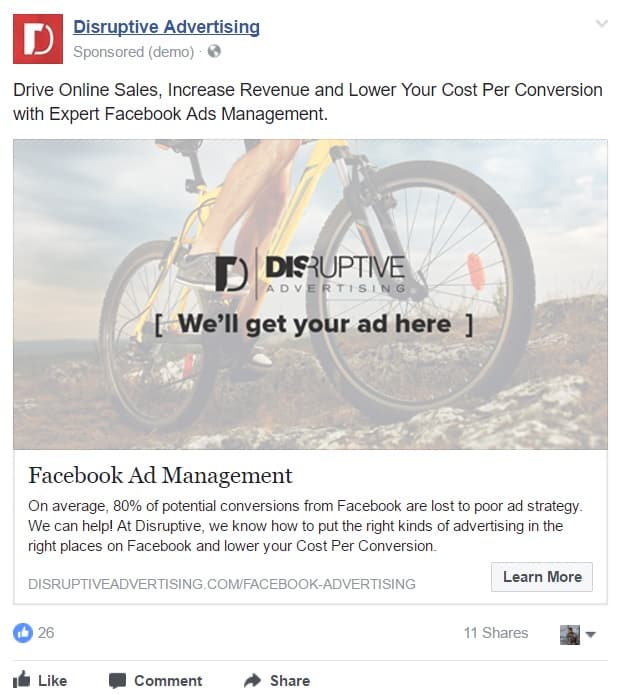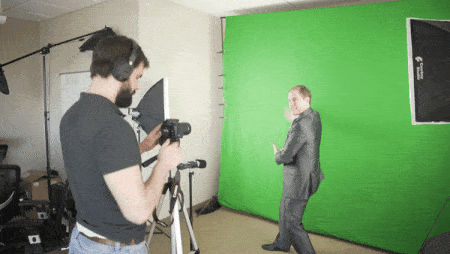What Type of Facebook Video Ad Should You Invest In? [DATA & CALCULATOR]
by Aden Andrus • June 15, 2017
Twenty years ago, only the biggest and most well-funded businesses could afford to run video ads on TV, but today, any company can get a video ad on Facebook or YouTube.
However, not all videos are created equal.
When you don’t have the deep pockets of a giant company like Chevrolet or Budweiser, creating a $1,000,000 video ad probably isn’t on the table. This begs the question, what sort of video ad quality do you need to get decent results?
Do you need a $1,000,000 commercial? Or will a $1,000 commercial suffice?
At Disruptive, we decided to test video ad quality on Facebook to see what sorts of results different levels of quality produced. Here’s what we discovered:
Video Ads vs Image Ads
Before we dive into the specifics of our test, it’s important to lay a little groundwork. No matter what the quality of your video is, video ads outperform image ads.
Over the past couple of years, we’ve spent over $100,000 dollars on Facebook. We’ve tried both lead ads and conventional ads with a landing page. We’ve experimented with video ads and static ads. We’ve promoted our blog posts extensively.
Across all our tests, we learned one very simple lesson: video is better than static image ads.
Lead Image Ads vs Standard Image Ads
At first, when we started using lead ads we—like most businesses—were very excited about our results. Overnight, our cost-per-lead dropped 87%.
Yes, you read that right: 87%!
Here’s a quick snapshot of one of our ads:

Thanks to Facebook’s handy prefilled forms (if you’re unfamiliar with lead ads, check out this article), the leads were rolling in so fast and so cheap that our poor sales team about had a heart attack.
And then…nothing.
We called, we emailed, we did everything we could to get a hold of these leads, but only ever got a response from about 10% of them. Compared with the response rates we were seeing with AdWords, this was appallingly low.
At the end of the day, while lead ads definitely drove a lot more lead volume than the standard “send them to a landing page” ad, our ultimate return-on-investment was about the same.
Lead Ads vs Video Ads
As you can probably imagine, after our experience with lead ads, we were feeling pretty frustrated. After years of refining, we knew we had the right audience. Based on the lead ads response, we were certain that the opportunity was there.
But, we just couldn’t get the results we wanted.
So, we decided to try video. Luckily, we already had some very talented film makers in house, so we were able to put together a few videos in a fairly short period of time.

We launched them on Facebook and held our breaths.
To our surprise, the results were even better than we had hoped. A bit jaded from our lead ads experience, we were sending clicks from our ads to a landing page and our cost-per-lead was still 44% lower than the cost-per-lead we had been getting with our lead ads.
In fact, our video ads were driving leads for 1/14th of the cost per lead we had been seeing with our standard image ads.
Of course, after our lead experience, we knew that lots of leads doesn’t mean much if those leads aren’t closing. However, our video ad leads were closing 2.2x more frequently than our lead ads.
As a result, the ROI for our video ads was over 6x higher than the ROI for our lead ads.
6x…and that’s including production costs!
With results like these, we were sold on video, but we wondered, Exactly how much time, effort and expense is necessary to get these kinds of results? Do we have to create an elaborate commercial or can we get good results from something simple?
Testing Video Ad Quality
At Disruptive Advertising, we’re all about testing, so we decided to start testing different levels of video ad quality.
To make sure we were comparing apples-to-apples, we tested our videos on the same audience, at the same time, with the same bids and pointed them all to the same landing page. We also tested standard image ads using the same parameters.
Although we have made much more involved and technically challenging videos, we wanted to create videos that even a fairly small business could afford to have made, so we compared 3 basic video types:
Simple Slideshow Ad
For these videos, we went as basic as possible. Rather than filming actual footage, we identified the pain points we wanted to target and crafted a narrative around those pain points. Then, we found stock photos that matched our narrative and created a “slideshow” ad like this:
As simple as these slideshow videos were, they still delivered great results in our tests. For example, despite the fact that we were pointing traffic to a landing page, our cost-per-lead for this ad was only 17% higher than our cost-per-lead was using lead ads—and the leads were much higher quality.
Live Action Short Commercial
While testing our slideshow video ads, we noticed that live footage seemed to outperform stock images (shocker, right?). So, we decided to film a live-action version of our slideshow video ads to see if telling the same story with live footage would deliver better results.
Here’s our live version of the previous slideshow ad, featuring yours truly:
Compared to the slideshow, the live action version of this ad had a 20% lower cost-per-lead. That meant it was delivering higher quality leads than our lead ads at approximately the same price point.
Live Action Long Form Commercial
Finally, we tested a longer-form commercial that hit on multiple pain points for our target audience. We took numerous shots around the office, paid a composer to create a score for the ad and included several bits of humor:
This video significantly outperformed the others. Compared to the slideshow, this video ad delivered leads at less than half the cost.
Comparing Video Ad Quality
After analyzing all of this data, we used it to create a quick calculator you can use to estimate how investing in each of these types of video ads will affect the profitability of your Facebook campaigns:
To use this calculator, simply enter your current Facebook image ad performance statistics (average cost-per-click, cost-per-conversion and profit-per-sale) into the designated sections.
Then, simply check the box of the image ad type you’re interested in and the calculator will give you an estimate of how running that video ad will affect your results.
Note, this calculator is not a guarantee of results. Different videos and different campaigns perform differently, but this calculator should give you a ballpark estimate of what you can expect.
In addition, this calculator also accounts for the investment cost of a video using Disruptive’s standard rates for creating each of these videos. If you choose to have your video made by someone else, your profit-per-sale may vary from these estimates.
In using this calculator, it’s important to keep in mind the longevity of different ad types. If you’re exclusively using a single slideshow ad, it has about a 1-month lifespan before people stop responding to it.
You can extend this lifespan to about 3-4 months by simultaneously running additional slideshow videos, but slideshow videos have a much faster turnover than live videos.
In contrast, we have run long-form, 60-second commercials for about 6 months without seeing any real decrease in performance.
So, while slideshow ads produce great short-term results, you have to keep creating more in order to keep getting the value out of them. On the other hand, longer live-action ads are a bigger initial investment, but they yield better long-term dividends.
As a result, the best option for your business will really depend on you, your budget and your goals.
Conclusion
After extensively testing how video ad quality affects your marketing, two things have become clear: 1) video ads beat image ads and 2) choosing what sort of video ad to run is a juggling act between cost and longevity.
In general, the higher the quality of your video ad, the better it will perform, but if you can only afford to make a simple slideshow ad…do it! The results can completely transform your advertising.
By the way, if you’re interested in having Disruptive create any of these types of video ads (or even a more involved ad—we’re good at those, too), let us know here or in the comments.
What do you think of these results? Did any of our findings surprise you? What sort of video ads have you tried?





